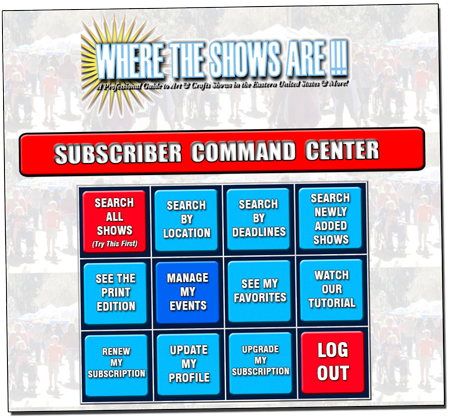The fact that exhibitors participate in art & craft shows is the “stock and trade” of a publication like “Where The Shows Are!!!” and that’s where we’ve focused our efforts for decades. There have been and always will be ups and downs in the show market as there have been and will be peaks and valleys in any market in which you may decide to become a part. Personally I’ve been in a few other successful businesses and I have several friends who own companies that have nothing to do with the art industry… and once again it’s the same story. So it’s my belief, based on years of personal experience, that no matter what industry you decide to participate… you’ll have to constantly be on the lookout for opportunities that can help smooth out those natural variations in sales. Although you could in theory run businesses that are totally dissimilar, most likely you’ll have more success by staying with a similar theme… but expanding the possibilities or marketing those talents. It’s that line of thinking that inspired me to write this article.
The events we list in this guide and that take place every week are at best a seasonal phenomenon… unless of course you’re willing to travel. For some that makes sense and I know that I’ve done it myself for many years. The shows are a very straight forward approach to marketing what you make… but for a wide variety of reasons that approach may not always be practical. So lets take a look at some other ways to market your work.
1. Take Your Idea To Industry. The nice thing about a show is that you simply set up and then depend on someone else to bring the customer to you. The  marketing of your skills are all done by someone else and you pay them a fee to bring in the customers. But that isn’t the only way to have someone bring in the customers. You can find them yourself by networking among friends too. And by doing this you aren’t limited to a Saturday and Sunday. Here are a few examples…
marketing of your skills are all done by someone else and you pay them a fee to bring in the customers. But that isn’t the only way to have someone bring in the customers. You can find them yourself by networking among friends too. And by doing this you aren’t limited to a Saturday and Sunday. Here are a few examples…
Almost every industry needs the skills of an artist from time to time. In most cases they don’t’ need those skills every day of the week so certainly a full time position wouldn’t be a consideration… but that works out to your advantage unless you’re looking for that kind of situation. Products or all sorts need illustration and graphic work all the time. I have a friend in the aviation industry and conceptual illustrations are a part of his daily work. Engines, wings, new canopies and more are illustrated before they ever go into production. Often times models are created too. That not only goes for aircraft, but for boats, cars, motorcycles, bridges, buildings, housing developments, graveyards, highway projects and just about anything else you can think of. The ability to create all this work is well within the skill sets of most people working in the field of art. Along with the models and drawings is they idea these can be taken one step further and animated so that designers, potential investors and other decision makers can actually visualize they way something will work. Translating ideas into reality is a great business and another way you as an artist or craftsman can work directly with other industries and in a very beneficial way.
 2. “Have It Your Way” in the construction and design world. The big box retailers would have you believe that the only way to decorate a home, build furniture or add accessories is to come to their store and purchase something made in a factory somewhere in a developing country. Well long before there were places like Home Depot, Ikea, Lowes, Rooms To Go and Wal-Mart, there were artists and craftsmen who interacted with the designers and builders to create just what the customer had in mind. If you can get beyond that mindset… the opportunity still exists today. How many of you could create the perfect stained glass piece for an entry way… or the perfect door for a shower enclosure? Why stick with some shelf from Ikea that will fall apart in a year or two when you could have something make with quality materials that would last decades? I’ll bet a lot of people remodeling a home or an office would gladly invite the opportunity to have just exactly what they want rather than settle for some design or idea that is mass produced. The trick here is to let the right people know what your capabilities are. If the architect is designing a building with the idea that Lowes will be supplying all the materials… then he’ll base his designs on that concept. If he knows you can provide something else… and turn his idea’s into reality then it expands the creative possibilities for both of you! Make sure you contact all the builders, architects, designers, remodeling companies, furniture stores and more in your area.
2. “Have It Your Way” in the construction and design world. The big box retailers would have you believe that the only way to decorate a home, build furniture or add accessories is to come to their store and purchase something made in a factory somewhere in a developing country. Well long before there were places like Home Depot, Ikea, Lowes, Rooms To Go and Wal-Mart, there were artists and craftsmen who interacted with the designers and builders to create just what the customer had in mind. If you can get beyond that mindset… the opportunity still exists today. How many of you could create the perfect stained glass piece for an entry way… or the perfect door for a shower enclosure? Why stick with some shelf from Ikea that will fall apart in a year or two when you could have something make with quality materials that would last decades? I’ll bet a lot of people remodeling a home or an office would gladly invite the opportunity to have just exactly what they want rather than settle for some design or idea that is mass produced. The trick here is to let the right people know what your capabilities are. If the architect is designing a building with the idea that Lowes will be supplying all the materials… then he’ll base his designs on that concept. If he knows you can provide something else… and turn his idea’s into reality then it expands the creative possibilities for both of you! Make sure you contact all the builders, architects, designers, remodeling companies, furniture stores and more in your area.
3. Retail Doesn’t Have To Go Overseas. There is probably no way you’ll be able to go to Wal-Mart, Sears or any other major retailer to get them to distribute your work. I’m not saying it’s impossible… but certainly improbable. And even if they did decide to carry your work they would probably provide terms that would have you living and working like a peasant in Siberia! The moral of this story is, forget about the big guys for the time being. You’d have to supply your work in such large quantities anyway that you probably couldn’t afford to do it… and even if you could convince someone to loan you the money to do it, these firms have bankrupted more than one company by stretching out payment to months! Then, to make matters even worse most of the really large buyers want “buy back” provisions in the contract that essentially make you responsible for their merchandise. This arrangement doesn’t leave a lot of reason to do business with the big guys.
The better prospect is a smaller retailer looking to be different. The smaller companies can’t compete on price with the big box guys and if they try then they’ll lose every time. Furthermore, if they stock the same merchandise as the big retailers… at a higher price, then no one in their right mind will buy from them. The smart thing for a small retailer to do is to find higher quality merchandise that is different from what you may expect to find a Wal-Mart or Lowes. That’s where you come in. As the artist or craftsman you can not only provide that different look and higher quality, you can supply the retailer in smaller, more affordable quantities that both of you can live with. It may be a little more expensive than what the customer may find at the larger competition, but the value will be much higher and the customer’s home or business won’t look just like everyone else. And because you’re producing in smaller quantities and a unique look, you wan work with feedback the retailer gets in order to tweak your work to match his clientele. Everyone wins! You won’t get every sale because some people will buy based on price regardless of what you offer them… but you’re small… your overhead is low and you don’t need every sale to make a reasonable living.
 4. Go Directly To The Buyers. It’s great when the buyers are looking for you and lined up to buy your work. Of course that is everyone’s dream, but it doesn’t happen all that often. So when the bank account is getting low and the customers aren’t lining up in front of you… it may be time to go to them! Chances are there really are people who want to buy, but they just don’t know what you have for sale. In fact, I’d be willing to bet that only a very few people you know are fully aware of what you do. That’s not really so unusual… of the people you associate with, how many of they do you know exactly what they do?
4. Go Directly To The Buyers. It’s great when the buyers are looking for you and lined up to buy your work. Of course that is everyone’s dream, but it doesn’t happen all that often. So when the bank account is getting low and the customers aren’t lining up in front of you… it may be time to go to them! Chances are there really are people who want to buy, but they just don’t know what you have for sale. In fact, I’d be willing to bet that only a very few people you know are fully aware of what you do. That’s not really so unusual… of the people you associate with, how many of they do you know exactly what they do?
The plan here is to gather together friends, family , acquaintances, co-workers, friends of friends and anyone else you can think of to do a presentation so they may purchase your work. Probably the best sort of business models that use the same approach would be something like Mary Kay, Tupperware, Christmas Around the World and those kind of marketing plans. This sounds easier than it is to accomplish, but it does work and the success of the companies that employ these techniques are testimony to this. This is a viable option when you’re considering a way to market what you do.
5. The Government Has Programs to Purchase Your Work. You’ll find more details about this in another article in this edition as we were fortunate enough to make contact with one of the directors of this project in Florida. These programs exist throughout the country and according the Lee Modica who directs the Florida program, there are over 450 government sponsored organizations who constantly look for and coordinate the purchase of art for public buildings. In addition to these opportunities, there are a multitude of other government programs if you take the time to look. Universities, cities and towns, individual government agencies, hospitals, the military, political campaigns and many others have a constant demand for artwork, jewelry, sewing, sculpture, stained glass, logo design, portraiture, photography and just about every other skill you also will see any given weekend at an event. These opportunities won’t usually come to you… but if you look for them you’ll find them because someone is doing this work every day of the week.
6. Arts Organizations Can Give You Exposure. Credibility and reputation are two of the most important attributes you can develop in order to be successful in the field of the arts regardless of what you do. The reality is that a great number of people really want to take advantage of the skills and talents you offer, but they have no way to judge whether they are getting something of tremendous value or something totally worthless. Of course this is always the problem artists or every discipline face when trying to sell their talent to someone who is not familiar with the arts. So one of the functions arts organizations can provide is that of credibility. When you display in one of their galleries, do a presentation for the organization, provide services to them and so forth the is often no immediate financial reward. What does exist however, is a kind of peer review of your talent. This is useful when trying to provide services to those who otherwise have a difficult time evaluating the potential you have to do the job they have in mind. All of the arts by their very nature are a completely subjective sort of thing influenced by personal tastes and the fickle public opinion of “what is good art.” Like fashion, the definition of good changes like the winds. Sometimes you’re in the right place at the right time and it all comes together… at other times you just happen to be the victim of having the right idea at the wrong time. But don’t be too discouraged… that can change in the blink of an eye!
in the field of the arts regardless of what you do. The reality is that a great number of people really want to take advantage of the skills and talents you offer, but they have no way to judge whether they are getting something of tremendous value or something totally worthless. Of course this is always the problem artists or every discipline face when trying to sell their talent to someone who is not familiar with the arts. So one of the functions arts organizations can provide is that of credibility. When you display in one of their galleries, do a presentation for the organization, provide services to them and so forth the is often no immediate financial reward. What does exist however, is a kind of peer review of your talent. This is useful when trying to provide services to those who otherwise have a difficult time evaluating the potential you have to do the job they have in mind. All of the arts by their very nature are a completely subjective sort of thing influenced by personal tastes and the fickle public opinion of “what is good art.” Like fashion, the definition of good changes like the winds. Sometimes you’re in the right place at the right time and it all comes together… at other times you just happen to be the victim of having the right idea at the wrong time. But don’t be too discouraged… that can change in the blink of an eye!
7. Market Your “Style” of Work and Develop Consumer Demand. You’ve seen this done when a new movie comes out. There are action figures, games, books all kinds of things are produced to support the movie. Sports teams do the same thing. Jersey’s with the team logo, hats, pictures, flags, cups and just about anything that can be seen or used will promote the organization. All this is called merchandising… and it’s a pre-calculated way to gain exposure, develop recognition and consumer demand all while making money at the very same time! It’s actually an amazing phenomenon isn’t it… they’ve convinced you to spend money for their advertising!
Well you may not be able to have the effect that the Orlando Magic or the Pittsburgh Steelers have had, but plenty of artists and craftsmen have developed a style and merchandising plan that has made them not only a recognizable figure… but plenty of money in the process. I’m sure you’ve heard of Thomas Kinkade, the “Painter of Light” or Bob Ross. Sure these guys got terrible reviews from the critics, but who cares! And then there are the “Checks & Dot’s” type of folk art done by Mary Englebright. You’ll see her work on everything from aprons, to greeting cards, to teapots to just about anything else you can possibly paint on. And of course we sure don’t want to forget about Martha Stewart! These people took a simple idea and ran with it. And they didn’t limit the scope of their thoughts. Today they and many others capitalize on the name and style they’ve embraced to create a veritable industry around those simple ideas. With licensing, merchandising, mall shops, clothing lines, books and much more… all based on what amounts to some basic ideas with one heck of a lot of marketing!
 8. Find an Agent. No matter how good you are… no matter how many credentials you carry… and no matter how much success you’ve had… when you start talking about your accomplishments it’s hard not to sound like you’re bragging. In fact, the more you’ve done… the more you run this risk and that apparent attitude can cost you as much work as it gains for you. But when a third party starts talking about you and your work. When he tells a prospect about all the wonderful things you’ve done and adds a whole lot of superlatives… it’s not bragging… it becomes the stuff of which future work and higher prices are made of!
8. Find an Agent. No matter how good you are… no matter how many credentials you carry… and no matter how much success you’ve had… when you start talking about your accomplishments it’s hard not to sound like you’re bragging. In fact, the more you’ve done… the more you run this risk and that apparent attitude can cost you as much work as it gains for you. But when a third party starts talking about you and your work. When he tells a prospect about all the wonderful things you’ve done and adds a whole lot of superlatives… it’s not bragging… it becomes the stuff of which future work and higher prices are made of!
A person who becomes your representative can be your best ally in part because they can get away with saying things about you that would be difficult for you to say yourself. In addition, since their income is dependent on your talent and people will tell them things they wouldn’t say to your face, these representatives can provide feedback to you that my otherwise be hard to obtain. If you’ve tried selling your work, made a proposal and then weeks later found out someone else got the job, mostly the people making the decision will just tell you some sort of BS about why they selected the other candidate. In some cases it’s not really BS… it’s just simply that they really couldn’t quantify why you didn’t get the job. A good agent will be sensitive to this kind of thing and since he’s probably much more objective than either you or the buyer his evaluation of the failure to get the work is probably more valid than any other opinion. Here you can work closely to decide if there are things you need to do to improve future presentations or maybe this particular instance is just simply a bad match for your talent. Remember, if the person you’re working with isn’t making money unless you actually get the work then they have a vested interest in making you a better, more saleable artist. On the other hand it’s also important for you to evaluate if this particular representative has a market for what you do. I’ve seen some artist experience dismal failure with one representative and tremendous success with another. Part of this relationship speaks well of the artist… and part of it speaks well of the agent. The best relationships speak well of both because after all, this really is a kind of partnership.
In many business there are a million ways to make a living. And sometimes we wind up putting on blinders to many of those new methods because we’ve had success in one area. Now that’s not altogether a bad thing… but if there is anything I’ve learned after making a living in the arts for the last thirty seven years… it’s that we must constantly keep our eyes open for opportunity. We must always be on the lookout for the next step in our careers and we must always be willing to at least try new ideas in your art along with new marketing ideas. Just as trends in the arts change with the winds… so do the ways in which we can make a living. A good friend of mine told me once… “when you’re green you’re growing, and when you’re ripe… you’re rotten!” Lets all try to keep green and growing in our chosen profession. By doing so we constantly keep learning and life will continues to be exciting no matter how long we live or no matter how long we decide to work in the field of the arts!


